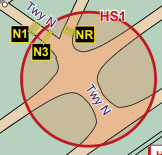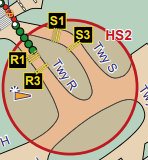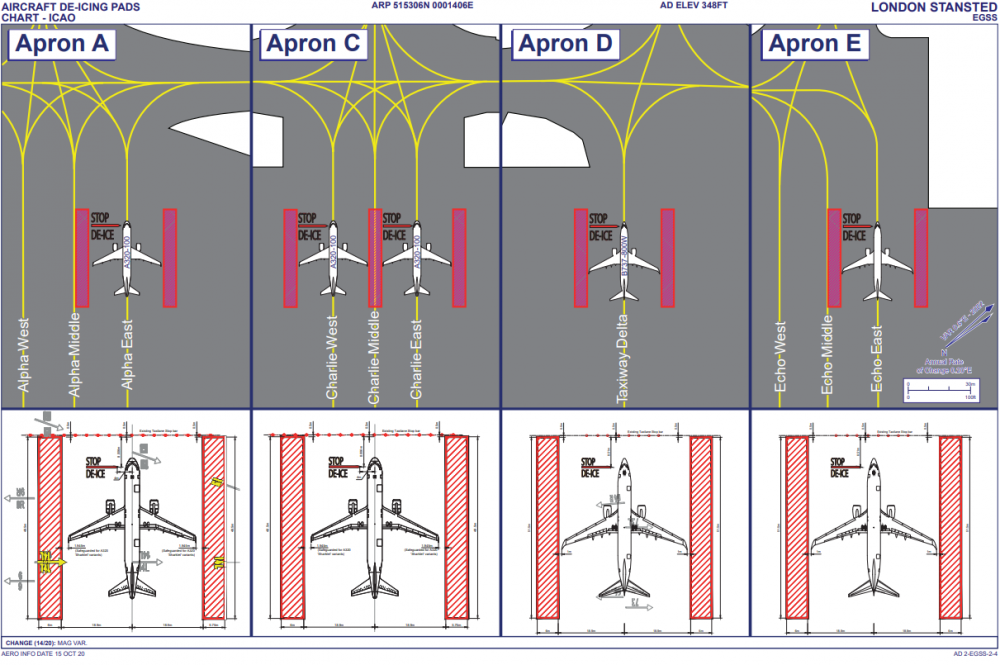Overview. London Stansted Airport (IATA: STN, ICAO: EGSS) is an international airport located in Stansted Mountfitchet, Essex, England, 42 mi (68 km) northeast of Central London.
Runway Use. In calm conditions, runway 22 is the preferred runway when the tailwind component is less than 5kts and the runway surface is dry.
Transponder Use on Ground. Once on the stand, set the transponder code to 2000 before switching it off.
Hotspots.
Scenery. There are multiple add-on sceneries available for London Stansted Airport. if you are using FSX/P3D, we strongly recommend that you download one because they incorporate recent updates that are not included in default scenery. If you decide to fly with scenery that is not included in the approved list, then make every effort to follow the controllers' instructions referencing the published taxiway diagrams.
| FSX/P3D Approved | X-Plane Approved |
| ➢ Stansted Xtreme | ➢ Stansted Xtreme |
Chart. Charts can be obtained from several providers, however, it is highly recommended you visit the NATS Aeronautical Information Service (AIS) which is accessible HERE. Stansted charts are available from THIS location.
Uncontrolled Operations. The following frequencies should be utilised only when POSCON ATC is offline.
| Station | VHF Frequency |
| Stansted ATIS | 127.180 |
| CTAF | 122.95 |
Terminal Layout.
Gate Assignment.
| FedEx | 204, 205, 213, 214 |
| Cargo | 1 - 6 |
| Other Pax | 10 - 15, 20 - 25 |
| EasyJet | 30 - 34, 40 - 45 |
| Ryanair | 50 - 65 |
Start-up Clearances. Start clearance will be provided once the aircraft is ready for pushback. Aircraft will request pushback once ready to do so from Ground. Single engine piston aircraft and smaller GA/business aircraft may not need pushback as can taxi straight off stand. Aircraft may be instructed to push back onto another stand if they have a slot to wait for so as not to obstruct the taxiway. In order to allow for another aircraft to taxi out or into an adjacent stand, aircraft may be instructed to carry out a ‘long push’ to abeam a specific stand.
CPDLC Login. CPDLC LOGON: EGTT
Taxi Procedures. The small taxiways (Lima, Mike, November, Papa, Quebec, Alpha, Bravo, Charlie and Delta) between taxiways Hotel and Juliet are to be referred to as ‘Links’ i.e. Link Alpha.
ATC will take care when giving taxi instructions, not to give instructions which breach the maximum wingtip clearance spacing required for operation into and out of the apron. If safe clearance is not available, the East and West taxiways should be abandoned for the centreline taxiway, or in other scenarios, the aircraft should not move within the apron until space exists. NB: The aircraft commander is responsible for not accepting an ATC clearance onto a taxiway that is not approved for the aircraft type. The following limits apply:
- The East/West taxi-lanes within aprons Alpha, Bravo, Charlie and Zulu are available to aircraft with a maximum wingspan of 36m.
- The centreline within apron Delta is available to aircraft with a maximum wingspan of 51.9m.
- Aircraft with a wingspan greater than 51.9m should refer to the A380 ground movement chart for restrictions.
Standard Taxi Routes.
| 22 Outbound – Link out of apron, Taxiway H | 22 Inbound – Link, Taxiway J |
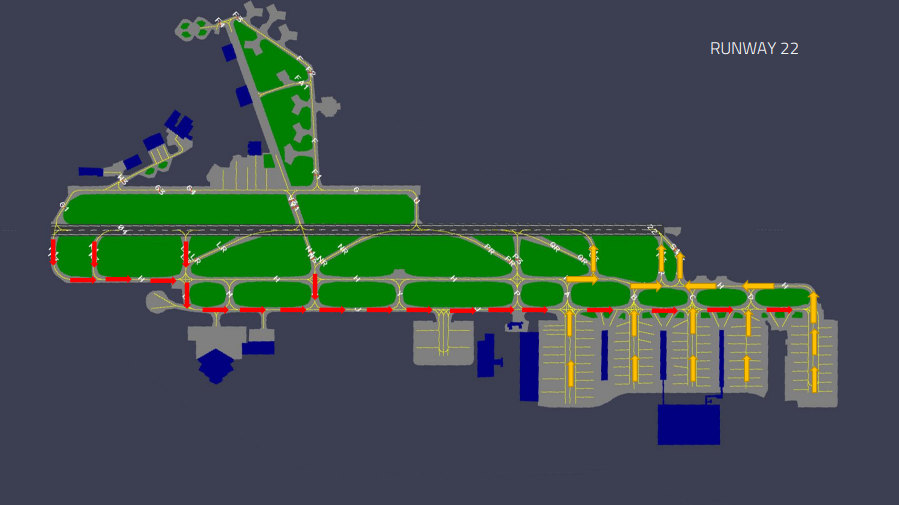 |
|
| 04 Outbound – Taxiway J, Link L, H | 04 Inbound – H, Link onto Apron |
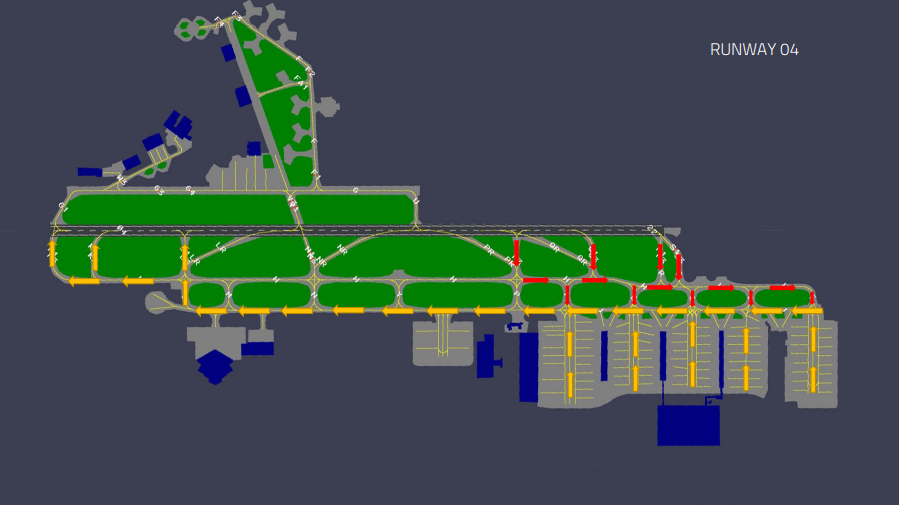 |
|
ATC Procedures.
| ESSEX1 | Essex Radar | 120.625 |
| SSINT1 | Standsted Director | 136.200 |
| SSTWR1 | Tower | 123.805 |
| SSGMC1 | Ground | 121.730 |
| SSGMP1 | Clearance Delivery | 121.955 |
Noise Abatement Procedures. Please refer to "EGSS AD 2.21 NOISE ABATEMENT PROCEDURES"
Speed Restrictions. Initial Approach Procedures are designed for manoeuvring speeds up to 220KIAS and assume aircraft can maintain a descent gradient of approximately 300 per NM.
Missed Approaches.
- RWY 22 - Climb straight ahead not above 3000. At I-SX DME 3.1 (VOR BKY R157) turn right to establish on VOR BKY R173 (QDM 353°) by BKY DME 8 continuing climb as necessary to BKY VOR at 3000 or as directed.
- RWY 04 - Climb straight ahead not above 3000. At I-SED DME 2 (VOR BKY R118) turn left to establish on VOR BKY R103 (QDM 283°). Cross BKY DME 5 at 3000* then continue to BKY VOR at 3000 or as directed. * Missed approach climb gradient of 4.9% may be required to ensure CAS containment.
ATC Procedures. Aircraft inbound via a STAR must follow the routing and level/speed restrictions as laid out in the appropriate chart. Normally, on the network aircraft will be vectored from either ABBOT or BKY to final approach, descending where appropriate. Aircraft must not however proceed beyond LOREL or ABBOT without ATC clearance but instead should enter the hold at either ABBOT or LOREL and await further instructions. Essex Radar handles the stacks and these are detailed below.
- LOREL: (Left hand turns, Inbound Course: 188)
- ABBOT: (Right hand turns, Inbound Course: 267)
1 minute legs. Standard Holding Speeds for the LTMA apply. (Up to and including FL140: 220kts, At FL150 and above Standard ICAO Holding Speeds)
From the stacks Essex Radar will hand inbound aircraft to Stansted Director who will vector the aircraft onto base and finally final approach for the appropriate runway.
